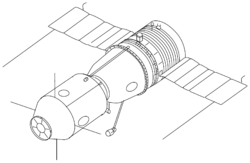Sojuz MS-10
| Sojuz MS-10 (Союз МС-10) | |||
| Beställare | Roskosmos | ||
|---|---|---|---|
| Modell | Sojuz-MS | ||
| Tillverkare | RKK Energia | ||
| Operatör | Roskosmos | ||
| Anrop | Burlak | ||
| Färdens tid | 19 min, 41 sek | ||
| Uppskjutning | |||
| Startplats | Bajkonur 1/5 | ||
| Start | 11 oktober 2018, 08:40 UTC | ||
| Raket | Sojuz-FG | ||
| Landning | |||
| Landningsplats | 20 km öst om Zjezkazgan | ||
| Landning | 11 oktober 2018, 08:59 UTC | ||
| Omloppsbana | |||
| Varv | 0 st | ||
| Apogeum | 93 km | ||
| Besättning | |||
| Besättning | Aleksej Ovtjinin Nick Hague | ||
 | |||
| Kronologi | |||
| |||

Sojuz MS-10 (ryska: Союз МС-10) var en flygning i det ryska rymdprogrammet. Den skulle flyga två astronauter till Internationella rymdstationen (ISS). Farkosten skötas upp med en Sojuz-FG-raket, från Kosmodromen i Bajkonur den 11 oktober 2018. Under uppskjutningen uppstod problem med Sojuz-raketen. Besättningen landade förhållandevis välbehållna, några minuter senare, utanför staden Zjezkazgan i Kazakstan.
Problem vid uppskjutningen
Drygt två minuter efter uppskjutningen uppstod problem med Sojuz-raketen. Räddningsraketen aktiverades automatiskt och separerade Sojuz-farkosten från raketen. Några minuter senare landade kapseln med de båda kosmonauterna, två mil öster om staden Zjezkazgan i Kazakstan.[1] Strax därpå nåddes kosmonauterna av de fyra helikoptrar med räddningspersonal som skickades dit och de flögs direkt till sjukhus i Zjezkazgan. De utsatts för starka g-krafter (6,7g[2]), men mådde efter omständigheterna bra och behövde inte medicinsk vård.
Några veckor senare la man fram bevis för att en av raketens förstasteg hade kolliderat med raketens andra steg. Detta lede till att raketen kom ur kurs, vilket automatiskt aktiverade räddningsraketen.
Besättning
| Befälhavare | Hans andra rymdfärd Expedition 57 / 58 |
|---|---|
| Flygingenjör 1 | Hans första rymdfärd Expedition 57 / 58 |
Reservbesättning
| Befälhavare | |
|---|---|
| Flygingenjör 1 |
Bilder
|
Källor
- ^ ”NASA” (på engelska). Twitter. NASA. 11 oktober 2018. https://twitter.com/NASA/status/1050316612304175104. Läst 11 oktober 2018.
- ^ Astronauts survive Soyuz rocket emergency landing CNN, 2018-10-11.
Externa länkar
 Wikimedia Commons har media som rör Sojuz MS-10.
Wikimedia Commons har media som rör Sojuz MS-10.
| |||||||||||||||||||||||||||||||||||||||||||||||||||||||||||||||||||||||||||||||||||||||||
| |||||||||||||||||||||||||||||||
| ||||||||||||||||||||||||||||||||
Media som används på denna webbplats
Rotated and color enhanced version of original (ISS013-E-48788 (6 July 2006) --- The Space Shuttle Discovery approaches the International Space Station for docking but before the link-up occurred, the orbiter went through a series of inspection photos by station crew to inspect the vehicle for any damage to its Thermal Protection System. This was known as the Rendezvous Pitch Maneuver and was implemented after the Columbia Disaster in 2003. The Leonardo Multipurpose Logistics Module can be seen in the shuttle's cargo bay. Discovery docked at the station's Pressurized Mating Adapter 2 at 9:52 a.m. CDT, July 6, 2006.)
Backdropped by a blue and white Earth, this close-up view features the Soyuz TMA-6 spacecraft approaching the International Space Station (ISS). Onboard the spacecraft are cosmonaut Sergei K. Krikalev, Expedition 11 commander representing Russia's Federal Space Agency; astronaut John L. Phillips, NASA ISS science officer and flight engineer; and European Space Agency (ESA) astronaut Roberto Vittori of Italy. The Soyuz linked to the Pirs Docking Compartment at 9:20 p.m. (CDT) on April 16, 2005 as the two spacecraft flew over eastern Asia. The docking followed Friday’s launch from the Baikonur Cosmodrome in Kazakhstan.
In this illustration, a SpaceX Crew Dragon spacecraft approaches the International Space Station for docking. NASA is partnering with Boeing and SpaceX to build a new generation of human-rated spacecraft capable of taking astronauts to the station and expanding research opportunities in orbit. SpaceX's upcoming Demo-1 flight test is part of NASA’s Commercial Crew Transportation Capability contract with the goal of returning human spaceflight launch capabilities to the United States.
Författare/Upphovsman: Pascal (Flickr user: pasukaru76), Licens: CC0
Vostok spacecraft replica at the Technik Museum Speyer, Germany.
Soyuz-TM spacecraft. Compare the antennas on the orbital module to those on Soyuz-T. Differences reflect the change from the Igla rendezvous system used on Soyuz-T to the Kurs rendezvous system used on Soyuz-TM.
The Soyuz MS-10 spacecraft is launched with Expedition 57 Flight Engineer Nick Hague of NASA and Flight Engineer Alexey Ovchinin of Roscosmos, Thursday, Oct. 11, 2018 at the Baikonur Cosmodrome in Kazakhstan. During the Soyuz spacecraft's climb to orbit, an anomaly occurred, resulting in an abort downrange. The crew was quickly recovered and is in good condition.
Apollo-Soyuz Test Project (ASTP) Soyuz. The APAS-75 docking unit is located at left.
The Soyuz TMA-04M spacecraft is seen after being rolled out by train to the launch pad at the Baikonur Cosmodrome in Kazakhstan, May 13, 2012. The launch of the Soyuz spacecraft, with Expedition 31 Soyuz Commander Gennady Padalka, Flight Engineer Sergei Revin of Russia and NASA Flight Engineer Joe Acaba, is scheduled for 9:01 a.m., May 15 (Kazakhstan time).
At the Gagarin Cosmonaut Training Center in Star City, Russia, Expedition 55 backup crew members Nick Hague of NASA (left) and Alexey Ovchinin of Roscosmos (right) pose for pictures during a day of qualification exams Feb. 20. They are serving as backups to the prime crew, Oleg Artemyev of Roscosmos and Ricky Arnold and Drew Feustel of NASA, who will launch March 21 on the Soyuz MS-08 spacecraft from the Baikonur Cosmodrome in Kazakhstan for a five month mission on the International Space Station.
The Soyuz MS-10 mission moments before launch, which was aborted due to rocket booster failure.
Launch of Soyuz MS-10 mission, which was aborted due to rocket booster failure.
Soyuz-A manned spacecraft concept (1963). It was to have been part of the Soyuz A-B-C circumlunar complex.
























